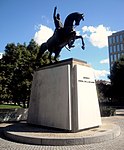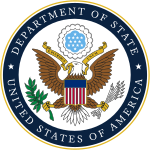Eccles Building

The Marriner S. Eccles Federal Reserve Board Building houses the main offices of the Board of Governors of the United States' Federal Reserve System. It is located at the intersection of 20th Street and Constitution Avenue in Washington, D.C. The building, designed in the Stripped Classicism style, was designed by Paul Philippe Cret and completed in 1937. President Franklin D. Roosevelt dedicated the building on October 20, 1937.The building was named after Marriner S. Eccles (1890–1977), Chairman of the Federal Reserve under President Roosevelt, by an Act of Congress on October 15, 1982. Previously it had been known as the Federal Reserve Building.
Excerpt from the Wikipedia article Eccles Building (License: CC BY-SA 3.0, Authors, Images).Eccles Building
Constitution Avenue Northwest, Washington
Geographical coordinates (GPS) Address Phone number Website Nearby Places Show on map
Geographical coordinates (GPS)
| Latitude | Longitude |
|---|---|
| N 38.892777777778 ° | E -77.045833333333 ° |
Address
Federal Reserve Note (Eccles Building)
Constitution Avenue Northwest 2001
20520 Washington
District of Columbia, United States
Open on Google Maps









